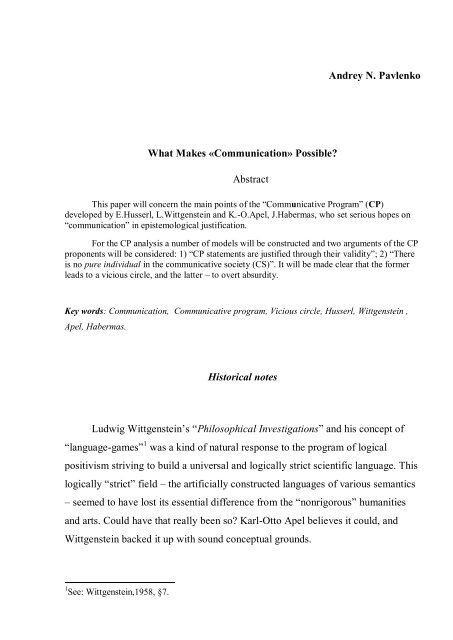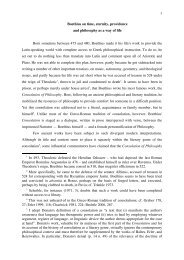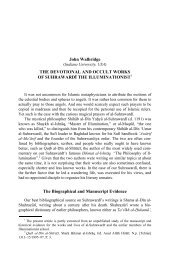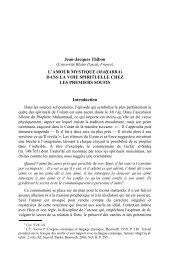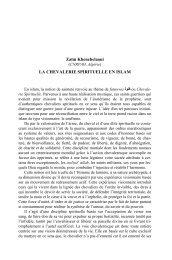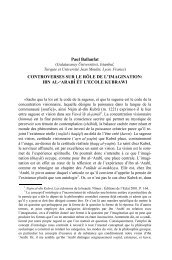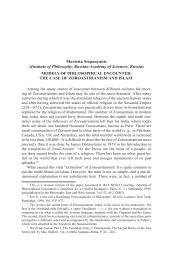Andrey N. Pavlenko What Makes «Communication» Possible ...
Andrey N. Pavlenko What Makes «Communication» Possible ...
Andrey N. Pavlenko What Makes «Communication» Possible ...
Create successful ePaper yourself
Turn your PDF publications into a flip-book with our unique Google optimized e-Paper software.
<strong>What</strong> <strong>Makes</strong> <strong>«Communication»</strong> <strong>Possible</strong>?<br />
Abstract<br />
<strong>Andrey</strong> N. <strong>Pavlenko</strong><br />
This paper will concern the main points of the “Communicative Program” (CP)<br />
developed by E.Husserl, L.Wittgenstein and K.-O.Apel, J.Habermas, who set serious hopes on<br />
“communication” in epistemological justification.<br />
For the CP analysis a number of models will be constructed and two arguments of the CP<br />
proponents will be considered: 1) “CP statements are justified through their validity”; 2) “There<br />
is no pure individual in the communicative society (CS)”. It will be made clear that the former<br />
leads to a vicious circle, and the latter – to overt absurdity.<br />
Key words: Communication, Communicative program, Vicious circle, Husserl, Wittgenstein ,<br />
Apel, Habermas.<br />
Historical notes<br />
Ludwig Wittgenstein‟s “Philosophical Investigations” and his concept of<br />
“language-games” 1 was a kind of natural response to the program of logical<br />
positivism striving to build a universal and logically strict scientific language. This<br />
logically “strict” field – the artificially constructed languages of various semantics<br />
– seemed to have lost its essential difference from the “nonrigorous” humanities<br />
and arts. Could have that really been so? Karl-Otto Apel believes it could, and<br />
Wittgenstein backed it up with sound conceptual grounds.<br />
1 See: Wittgenstein,1958, §7.
Wittgenstein‟s favourite illustration repeated throughout his “Philosophical<br />
Investigations” – the reasoning on “colours” – is strongly allusive of Edmond<br />
Husserl‟s argumentation in his “Logische Untersuchungen” [Husserl ,1922], as he<br />
aimed at justifying the “semantic unity of notion” and the “identity of propositions<br />
content”. <strong>What</strong> propositions? Those about “colours” (“what is green, is not red”)<br />
and those about the Euclidean geometry (“the total of a triangle angles is equal to<br />
180 0 ” etc). Of course, Husserl meant the ideal semantic unity and the ideal identity<br />
of content. The thing is that the truth, according to Husserl, has an ideal nature and<br />
reveals itself “as an idea grasping the essence of empirically random acts, or as the<br />
idea of absolute adequacy as such” [Husserl, 1922, S.123]. But this ideal nature<br />
itself needed justifying. <strong>What</strong> could have served for this? In Husserl‟s eyes, it<br />
might have been provided by the “intersubjective program” designed to bring to<br />
light the ideal nature of notions and assertions; he describes it in his work<br />
“Phänomenologie der Intersubjektivität” [Husserl, 1973]. Yet, this ideal nature is<br />
seen only if we admit the existence of the transcendental subject (Ego), and in such<br />
a way that it could be proliferated: seen as a multitude of subjects – the<br />
“intersubject”. “To reveal methodically the transcendental intersubjectivity and its<br />
turning into the transcendental community, - Husserl says, - is possible only<br />
proceeding from the concept of Ego and the system of its transcendental functions<br />
and actions” [Husserl,1973, S.189].<br />
However, Husserl‟s intersubjective program itself had to face some serious<br />
difficulties. Thus, we can construct a model of “one single subject” who, as «one –<br />
ένάς» and as having his «foundation – αρχή» in himself can be differentiated as and<br />
be given the name of Enarch. We have already shown [<strong>Pavlenko</strong>, 2004] that, in<br />
this case, it is not necessary to turn to a multitude of subjects for justification of the<br />
ideal unity of notion or of the propositions about colours and Euclidean geometry.<br />
Apel points out another difficulty. He proceeds from the fact that a program<br />
based upon the “obviousness of consciousness”, represented, in his opinion, by<br />
Descartes, Kant and even Husserl, has exhausted itself and proved insufficient for
“justifying the significance of „cognition‟ – which is manifest, for example, in the<br />
a priori significance of the Euclidean geometry in a Kantian mood, or the so-called<br />
Farbsätze in the mood of Husserl. Why is this so? In Apel‟s opinion, such<br />
“phenomenological and cognitive-anthropological stating is based on the ordinary<br />
visual obviousness of individual phenomena” [Apel,1972, S.2]. In other wording,<br />
each one, compos mentis, contemplates the world as Euclidean and as having<br />
appropriate colours. We can think of non-Euclidean metric, or of some principally<br />
different combinations of colours, but we cannot visualise such things!<br />
This shortcoming of the aprioristic and phenomenological approaches<br />
should be overcome: “It is exactly because of this that the justification of the<br />
Euclidean geometry or the Farbsätze intersubjective significance is insufficient<br />
here” [Apel, 1972, S.2]. Such justification, Apel believes, demands that obvious<br />
visualization should go together with a kind of “language-game”. This means that<br />
ordinary individual visualization should be “raised” above the individual to the<br />
transcendental level. How can this be achieved? Only in a special “communicative-<br />
semantic field” where “my personal obviousness” is combined with the “common<br />
significance for us”. Thus, Apel corrects Kant and Husserl as his follower,<br />
replacing the “apperception synthesis” by the “communicative interpretation<br />
synthesis”. This was the turning point from the “consciousness analysis” to the<br />
“communication analysis”.<br />
The thing is that, within the scope of reasoning, – however doubtful and<br />
sceptical the polemist himself might be – it is he who sets the “transcendental<br />
premises” and at the same time acknowledges them: both for epistemology and for<br />
a science on the lines of a transcendental language-game of an unlimited<br />
communicative society. Wittgenstein, too, speaks on the common (communicative)<br />
linguistic “behaviour” in his “Philosophical Investigations”: «206. The common<br />
behavior of mankind is the system of reference by means of which we interpret an<br />
unknown language» [Wittgenstein, 1958].
Apel supposes that the path should be leading from Kant‟s “transcendental<br />
idealism” and Husserl‟s phenomenology – through the synthesis of later<br />
Wittgenstein‟s “language-games” and Charles Pierce‟s “indefinite community of<br />
investigators” – to his own “transcendental pragmatics”. In such “transcendental<br />
communicative society”, the truth is understood like this: “any obviousness of<br />
consideration is stated due to the linguistic understanding of a proposition a priori<br />
significant for us, and may further retain its meaning in the conventional theory of<br />
truth (in Sinne Konsens-Theorie der Wahrheit) as an a priori bound knowledge”<br />
[Apel, 1972,S.3]. It is so because, in communication, the transcendental core of<br />
any individual ego coincides with the transcendental core of the entire society of<br />
the communication participants, both real and possible.<br />
<strong>What</strong> does Apel need this synthesis for? He sees it as the only way to<br />
overcome, on the one hand, the centuries-old chasm between the “sciences about<br />
the spiritual matters” and “sciences about the nature”, and on the other hand, to<br />
transcend the Cartesian and Kantian tradition of the “subject-object” dissection of<br />
the world when describing. He considers it possible in a special field that he calls<br />
“transcendental pragmatics”. <strong>What</strong> does it actually mean? It means that in both<br />
spiritual and natural kinds of sciences we have to deal with the same absolutely<br />
unavoidable procedures – “interpreting” and “understanding” in the frames of a<br />
“transcendental communicative society”. And he adds: when all claims of the<br />
“language of propositional calculus” for the role of the unique language of science<br />
have failed, that is, after there have emerged new constructive semantic systems –<br />
this “strict” field does no longer differ essentially from the “non-rigorous” spiritual<br />
sciences.<br />
So, we can see that certain “communicative expectations” were invariably<br />
inherent in Husserl‟s philosophy, and in Wittgenstein‟s, and in Apel‟s. This<br />
provokes a question: is really the “communicative program of knowledge<br />
justification” so substantial?
To answer this question I am going to examine this program only in one its<br />
bearing: for example, how validity of judgements can be made good in its frames?<br />
It has been shown above that Husserl associates validity with the identity of a<br />
notion‟s semantic unity for different transcendental subjects. Wittgenstein doubts<br />
the very status of “identity” as such, preferring to it the “comparison of equality” 2 :<br />
“254. The substitution of "identical" for "the same" (for instance) is another typical<br />
expedient in philosophy” [Wittgenstein,1958].<br />
For Apel it is the “statements a priori significant for us”, based, in the final<br />
analysis, upon the conventional theory of truth. In other words, for the CP<br />
representatives, the sign of a statement trustworthiness is its validity. Here, as I see<br />
it, communicative expectations encounter a grave difficulty.<br />
2. Crucial arguments against communicative program<br />
2.1. First argument: Vicious circle in justifying of epistemological<br />
validity.<br />
2.1.1. A distinction between logical and epistemological validity.<br />
To analyse the “intersubjectivity” reached in communication, let us<br />
introduce some designations, to help us make clear its logical and epistemological<br />
structure.<br />
Step 1. The variables x1,x2,x3……xn are introduced to designate certain<br />
classes of theoretical models.<br />
2 «216. "A thing is identical with itself." –There is no finer example of a useless proposition, which is yet<br />
connected with a certain play of the imagination. It is as if in imagination we put a thing into its own<br />
shape and saw that it fitted». [Wittgenstein,1958]
Step 2. A set of subjects of epistemology is introduced, designated by the<br />
symbols А1,А2,А3,……Аm.<br />
As we presuppose that different subjects, like А1,А2,А3,……Аm, understand<br />
propositions of theoretical models x1,x2,x3……xn in an identical way, that is, that<br />
the meanings inherent in the objects described by propositions x1,x2,x3……xn fully<br />
coincide, let us agree that<br />
Step 3. there is a “one-to-one correspondence (OOC) of meanings of the<br />
propositions x1,x2,x3……xn for all subjects А1,А2,А3,……Аm. Let us describe this<br />
correspondence as an equivalence, which will result in the following expression:<br />
[I] А1(x1,x2,x3…xn,) А2 (x1,x2,x3…xn,) А3(x1,x2,x…xn,), … Аm<br />
(x1,x2,x3…xn).<br />
where symbol «» means logical equivalency.<br />
Step 4. Satisfiability of such OOC is what we shall call the “intersubjective<br />
justification” of the propositions x1,x2,x3……xn.<br />
In other words, when there is a OOC in understanding of the propositions<br />
meanings in all explanatory models – then we can speak of achieving the<br />
“intersubjective justification” for these models.<br />
Step 5. On the grounds of our conclusions to steps 3 and 4 let us agree<br />
preliminary to call the correspondence [I] the epistemological definition of<br />
validity.<br />
An important reservation should be made here: the epistemological<br />
definition of validity should not be mixed with its logical definition as a tautology<br />
(an identically true formula).<br />
Having made all these assumptions, we still have to admit that the answer is<br />
not yet clear for a most important question: can we consider such OOC to be<br />
identical to epistemological validity? Most likely, we cannot! For, e.g., OOC may
e applied only to the variables already available for the researchers<br />
А1,А2,А3,……Аm. But there are scientific propositions not included into their<br />
scope at the discussed moment, and some more from merely theoretical sphere<br />
(e.g., mathematics) having no direct relation to natural sciences. Hence, we can<br />
conclude that it is necessary to differentiate between the two types of<br />
epistemological validity. Let us call them:<br />
1) Factual epistemological validity (FEV). It takes place when validity is<br />
applied for a finite set of propositions x1,x2,x3……xn and a finite quantity of<br />
subjects А1,А2,А3,……Аm in the sense [I].<br />
2) Analytical epistemological validity (AEV). In this case validity is applied<br />
for any preset proposition x1,x2,x3…xn….. and for any possible subjects of<br />
discussion А1,А2,А3,.…Аm… Then we have an equivalence of another kind:<br />
[II] А1(x1,x2,x3…xn…..)А2 (x1,x2,x3…xn….)А3(x1,x2,x…xn....,)…Аm<br />
(x1,x2,x3…xn….)….<br />
Let‟s take an example of FEV. Think of “phlogiston” as a special state of<br />
matter able to transfer heat. Its existence had validity for S. Carnot and his<br />
contemporaries in the sense [I], but then it lost its explanatory meaning. In other<br />
words, the notion “phlogiston” gets out of use in the scientific language of<br />
thermodynamics. So, it had validity for the 18th–early19th-century physicists and<br />
chemists, but does not have such for today representatives of the same branches of<br />
learning.<br />
This means, it can never have validity in the sense [II], as being not valid<br />
for any preset researcher. Wittgenstein would have simply explained this by<br />
different “language-games”. But – think of the both principles of thermodynamics,<br />
formulated by Carnot on the assumption of phlogiston existence and retaining their<br />
scientific meaning up to now, notwithstanding the linguistic unit “phlogiston” has
lost it. So, the nature of validity of the thermodynamics principles is rooted<br />
somewhere else. As a matter of fact, AEV can be reached solely by deduction. It is<br />
simply proved analytically – a thing Carnot did with the use of “the ideal thermal<br />
machine” model.<br />
This is why tautologies (laws, identically true formulae) from mathematics,<br />
logic, theoretical physics and other analytical spheres of knowledge also belong<br />
here.<br />
2.1.2.. The vicious circle in justifying FEV<br />
Having ascertained the existence of epistemological validity of two different<br />
types, let‟s ask a question: On what grounds we call a proposition justified<br />
intersubjectively (communicatively)? The answer that follows from the above says:<br />
On the grounds of its FEV. Indeed, the validity of a statement – let it be a<br />
proposition from the model x1 – is made manifest because the statement is used by<br />
all participants of the discussion, or simply by the inductive opinion examination<br />
of all participants in order to establish the fact of validity:<br />
А1(x1)А2 (x1) А3(x1)…… Аm(x1)<br />
Having examined opinions of all participants we give the following answer:<br />
the proposition from the model x1 is justified intersubjectively (communicatively)<br />
because it has FEV. Of course, we speak here of the enumerating induction. FEV<br />
includes the number of subjects of communication(A) as large as it is wished but<br />
finite, and the similarly finite number of models(x) (statements).<br />
If this is really so, we can ask the following question: on what grounds we<br />
say that a statement has FEV?
The answer we are going to hear is: on the grounds of the fact that the<br />
statement is justified intersubjectively (literally – that all participants of the<br />
discussion understand the discussed propositions (their “meanings”) identically,<br />
that is, an equivalence takes place. So, we cannot help having it this way:<br />
epistemological validity is proved through intersubjectivity (communicativeness),<br />
whereas the status of the latter is proved through epistemological validity.<br />
We cannot escape a certain vicious circle in any “intersubjectivity”<br />
justification. In my opinion, this is due to the fact that, seeking to prove the<br />
intersubjectively interpreted validity we, actually, deal with the inductive way of<br />
conclusion. Its main shortcoming – the non demonstrative character of conclusions<br />
is extended to the communicative justification of knowledge.<br />
As I see it, the problem is rooted in the fact that, within the frames of<br />
intersubjective approach, epistemological validity can never be justified because<br />
the very process of intersubjective justifying of formal-contentual (such as physical<br />
ones) and contentual (e.g., sociological ones) theories is based on the inductive<br />
generalisation instead of deductive conclusion: an example here may be – getting<br />
the intersubjective proof for a registered supernova outburst in different<br />
observatories of the world, etc.<br />
If that is the way it is, AEV as including an open class of subjects and<br />
statements, cannot be inductively proved in principle. The only way to ground it<br />
properly is deduction – for example, for a certain class of formulae in propositional<br />
logic, tautological as they are, etc.<br />
3. Second argument: Impossibility of a “pure individual”.<br />
3.1. Historical notes.<br />
Let us dwell on the argument referring to the impossibility of a “pure<br />
individual” and, therefore, of a “monologue”.
The assertion that an “individual” cannot be and is not “pure” as related to<br />
the communicative society is equally coherent to both Wittgenstein and Apel and<br />
to Habermas.<br />
Wittgenstein asks in his “Investigations on Philosophy”, fragment 199:<br />
«199. Is what we call "obeying a rule" something that it would be possible<br />
for only one man to do, and to do only once in his life?--This is of course a note on<br />
the grammar of the expression "to obey a rule".<br />
It is not possible that there should have been only one occasion on which<br />
someone obeyed a rule. It is not possible that there should have been only one<br />
occasion on which a report was made, an order given or understood; and so on».<br />
The answer is unambiguous: it is impossible! Where then words are<br />
“checked” by the rules of a language game? This takes place in “practical<br />
activities”: «206. The common behavior of mankind is the system of reference by<br />
means of which we interpret an unknown language (italics added – А.P.) »<br />
[Wittgenstein, 1958]. Speaking in the terms of this work – it is “communicative<br />
society” that is taken as the system of references.<br />
Similar views are expressed also by Apel when he says of a communication<br />
participant [Apel,22]. Without this transcendental premise of cognition, the latter,<br />
in Apel‟s opinion, could not turn into an argument. And this means that neither<br />
Kant nor Fichte had realized it and therefore were not able to substantiate cognition<br />
satisfactorily. It is important for us to stress Apel‟s intention to state the very<br />
“identical indistinguishability” of the cognizing “I” and the transcendental<br />
communicative society, practically dissolving that “I” in itself. Taking into<br />
consideration the fact that the transcendentalism of Kantian consciousness is<br />
transformed into the transcendentalism of language, Apel makes also the next step:<br />
of the “I” being dissolved, when speaking of a subject of science and commenting<br />
upon Wittgenstein‟s approach [Apel, S.20].<br />
Habermas gives utterance to a new program of philosophic thinking also,<br />
changing the subject by CS [Habermas, P.19].
An author has the right to pronounce any ideas, which, however, does not<br />
free him from responsibility. So, it is rather the right of pronouncing “any<br />
consistent ideas”. Here, of course, we shall bear in mind that our field of interest is<br />
epistemology. So we find it necessary to note that the epistemological concept<br />
denying the very existence of a self-supporting and “independent individual” meets<br />
at least two intrinsic difficulties that we shall express in the form of two theses: the<br />
strong and the weak ones.<br />
3.1.2. The strong thesis: “a separate individual has nothing that were not a<br />
product of a community”<br />
If we assume that there exists a “bound and only bound individual”, who is<br />
an entity having nothing in themselves except what is produced by a community,<br />
then we‟ll have to state a real peril of absurdity. I‟ll make it clear.<br />
Let‟s represent the argumentation of the communicative program<br />
proponents, in respect of the “impossibility of the existence of a pure individual”,<br />
in the form of clear-cut categorical judgments, that is, simply build a social-<br />
communicative model. It should be noted from the beginning: despite the modeled<br />
conditions are ideal, they correspond, nevertheless, to the essential features of the<br />
communicative program and namely to such extreme case when man is denied any<br />
“extra-communicative individuality” whatsoever.<br />
In a sense, we are building here a model of a “communicative society”<br />
stating the basic or, if you wish, the most important conditions of the<br />
communicative program. Of course, one cannot expect a model to “fully<br />
correspond to the reality” of a communicative society – simply of communicating<br />
people. But there is no need in such claim. The task is exactly in the fact that this<br />
model should reflect the essential features of real communication, impossible,<br />
according to its proponents, without them in principle.<br />
With this purpose, let us introduce such notions as “communicative society<br />
(CS)” and “an individual”. Several preliminary assumptions seem necessary:
а) The notion “CS” will be taken in its non-collective meaning, as the<br />
aggregate of individuals it consists of.<br />
b) An “individual” will be understood as an element of this CS, a cognizing<br />
and knowing entity.<br />
c) All other characteristics of a human individual will be left aside.<br />
d) We can assume both a CS consisting of a large and even great number of<br />
individuals, and a CS consisting of one single individual.<br />
e) “An individual‟s characteristics are defined by the CS”, that is, an<br />
individual is produced by the society, exists in the CS and hence is its medium.<br />
Having thus introduced the necessary notions and conditions for their<br />
interpretation, let us formulate several statements applied to them:<br />
α) a CS consists of individuals.<br />
β) Every individual as a separate entity has nothing in him which were not<br />
produced by CS.<br />
The truth of the (α) statement seems obvious for there is no such society that<br />
did not consist of individuals. Even in the extreme case – when there is only one<br />
individual – this “society” will nevertheless be a nonempty set. On the other hand,<br />
there is hardly anybody ready to state a society does not consist of individuals.<br />
The truth of the (β) statement is not so obvious. Though, we have agreed to<br />
think that the discussed model, however artificial it were, corresponds to the real<br />
state of things in the communicative epistemology. This means that the<br />
communicative program proponents are themselves set on the ideal of eliminating<br />
all conditions of “monologue nature” or, to use Apel‟s wording, of the “methodical<br />
solipsism”. <strong>What</strong> does this mean? For us, it means that any participant of<br />
communication must minimize his “individualistic qualities” for the sake of the<br />
society. Thus, if we ask the communicative program proponents: “why monologue<br />
does not exist?”, we shall hear in answer: “because there is no pure individuals”.<br />
And further on: each individual is an Individual solely because he is a product of<br />
social relationships (Marx), a total of communicative acts (Habermas), whose “I”<br />
is equal to the transcendental community (Apel). In other words, it is social
elationships, actions, values, regulations and standards that speak through the<br />
“language of an individual”. Exactly this interpretation of the nature of individual<br />
is expressed by the (β) statement.<br />
Now, if statements (α) and (β) are true we can, basing upon their content,<br />
make the following conclusion:<br />
γ) CS consists of individuals each of whom separately does not have<br />
anything that were not a result of the society’s actions.<br />
We have obviously come to absurdity. For, if each individual separately has<br />
nothing that did not belong to the “whole CS”, then the “CS” itself must contain<br />
“something” that can fill the emptiness of a separate individual. But as the entire<br />
CS consists of individuals having nothing in themselves, this “CS of individuals”,<br />
interpreted in a non-collective sense, can contain simply nothing.<br />
3.1.2.2. The weak thesis “the community is primary and an individual is<br />
secondary”<br />
The above said might be argued in such a way that, of course, there are no<br />
“pure individuals” having no individuality at all. It is present in everyone, the only<br />
thing is that this individuality is “secondary” as related to the “primary role” of<br />
communicative society.<br />
Now let us examine this argument of the primary role of communicative<br />
society and the secondary place of an individual.<br />
Here two more statements will be formulated:<br />
а) CS, being primary, consists of individuals, whose individuality is secondary.<br />
b) Each individual has an individuality that has nothing transcending the primary<br />
qualities that are all results of the CS actions.<br />
Uniting these two, we get a conclusion:<br />
c) CS, being primary, consists of individuals having individuality that has nothing<br />
transcending the primary qualities that are all results of the CS actions.<br />
So, we‟ve come to absurdity once more. For, if the “individuality” of a<br />
separate individual is secondary as related to the “collectivity” of CS, it means that
the whole CS consists of individuals whose individual qualities are secondary as<br />
related to the collective qualities of the whole CS. But as we have agreed to<br />
interpret CS in the non-collective meaning, i.e. that in the whole CS there can be<br />
nothing that are not contained in the aggregate of the “individualities” of its<br />
members, that means that the CS itself can have nothing but the “individualities”<br />
of the individuals it consists of. And if this is so, then no “collective” qualities of<br />
CS can be primary as related to “individual” qualities of an individual. Therefore,<br />
the thesis of the “primary role of CS as related to the secondary role of an<br />
individual” is also false.<br />
Here we must bear in mind that, as we remain within the frames of<br />
epistemology, the understanding of the essence of the criticism of the above<br />
statements may be hindered by the commonplace ideas transferred, by analogy,<br />
into the field of epistemology. Let‟s have an example.<br />
Imagine a ton-heavy stone lying on a footpath after a hurricane. Of course,<br />
no individual, however strong, won‟t be able to move it away from the path. But if<br />
fifteen individuals come and try hard together, that is, collectively, summing up<br />
their efforts, they might manage. The stone will be moved away not by a separate<br />
individual, but by a community of individuals, which is in this case a simple sum of<br />
physical efforts of separate individuals. A community here is also taken in the non-<br />
collective sense: there is nothing but the sum of abilities of separate individuals in<br />
it. This is a very simple example on merely mechanical movements in the space.<br />
However if we take a more complicated task and “ask” a community – taken<br />
again in the non-collective sense – to prove a theorem, compose a symphony or<br />
write a poem, instead of moving the stone – the situation will be different<br />
altogether. Even if we sup up the efforts of fifteen individuals able for this kind of<br />
work we won‟t get the theorem proved, the symphony composed or the poem<br />
written. Why? In our opinion, it is because in the rational sphere the<br />
communicative joining of efforts of separate individuals cannot be looked upon as<br />
a simple “sum” of their activities as it is in mechanical sphere.
The main conclusion we‟d like to make basing on the above arguments is<br />
this: communication itself adds nothing to what individual has already had himself.<br />
It would be naïve to deny the role of communication in transmitting<br />
knowledge, in learning, criticism etc. But stating that communication as such<br />
contains in itself something more (or able to give more) than the aggregation of the<br />
communicating individuals has already had inevitably leads to the absurd<br />
consequences described above.<br />
So, we have to state serious difficulties in justification of the CP. Of course,<br />
the enormous contribution to the communicative strategy development made by<br />
Husserl, Wittgenstein, Apel and Habermas can hardly be overestimated. Yet, the<br />
expectations placed by the mentioned philosophers and their followers in<br />
communication, have proved to be unreasonably overestimated as compared to the<br />
communicative reality – where the vicious circle described here and the difficulties<br />
connected with «a pure individual” are just trifles in a whole number of serious<br />
flaws.<br />
Literature<br />
Apel Karl-Otto,1972, Die Kommunikationsgemeinschaft als transzendentale Voraussetzung der<br />
Sozialwissenschaften//Dialog als Methode, Neue Hefte für Philosophie, Göttingen, Hf.2-3.<br />
Habermas Jürgen, Moral Consciousness and Communicative Action . Trans. Christian Lenhardt<br />
and Shierry Weber Nicholsen. Introduction by Thomas McCarthy. Cambridge, MA: The MIT<br />
Press, 1995.<br />
Husserl Edmund, 1973, Phänomenologie der Intersubjektivität, Den Haag, - T.2.<br />
Husserl Edmund,1922, Logische Untersuchungen. Dritte, Unveränderte Auflage, - Hallea.d.S.,<br />
Bd. 2, Teil II.<br />
Heidegger Martin, 1976, Logik. Der Frage nach der Wahrheit//Gesamtausgabe,- Fr.a.M., Bd.21.<br />
<strong>Pavlenko</strong> <strong>Andrey</strong>, 2004, “Theorem about The Back of the Head”//Skepsis, Academia Verlag –<br />
ENNOIA, Vol. XV ii, p. 210-224.
Wittgenstein Ludwig, 1958, Philosophical Investigations, Second Edition, translated by<br />
G.E.M.Anscombe, Blackwell Publishers Ltd, Oxford, UK<br />
Резюме<br />
В данной работе анализируются основные тезисы «коммуникативной программы»<br />
(КП),развиваемые в работах Э.Гуссерля, Л.Витгенштейна, К.-О.Апеля, Ю.Хабермаса,<br />
возлагающих огромные надежды на способность «коммуникации» быть основой<br />
эпистемологического обоснования знания. Для анализа КП построено несколько моделей,<br />
которые позволили прояснить и реконструировать два аргумента КП: 1) Утверждения КП<br />
обосновываются через общезначимость; 2) В коммуникативном сообществе не<br />
существует «чистых индивидов». Показано, что первое утверждение содержит логический<br />
(порочный) круг, а второе логически строго приводит к абсурду.<br />
Ключевые слова: коммуникация, коммуникативная программа, порочный круг, Гуссерль,<br />
Витгенштейн, Апель, Хабермас.


